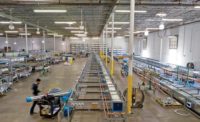Existing cross bridges along LBJ created constructibility issues because of low vertical clearance and crane placement constraints, Muñoz explains. So the team developed a new truss system.
"Built at 270 feet long, 8 feet tall and 6 feet wide, the bright blue truss system included an electrical generator with wireless remote control, two electrical trucks to move the truss along tracks set on the caps and two electric winches to lift and place the beams," explains Joaquin Losada, Trinity construction manager. "Traditional cranes typically used along the project weigh hundreds of tons and require clear level paths and large set-up areas. In contrast, this custom-built truss system moves along the caps of the bridge, ideal for low clearances, and removes the need for massive crane paths or pads."
Collaborating with VSL International, the LBJ Express team spent months laying out plans to implement the truss method, he says.
"The truss system was conveniently built on top of existing bent caps, which provided ample support for the system," Losada explains. Electric trucks ran on dual rails, which were bolted to the top of the concrete caps to launch the concrete beams from one span of the bridge to the next. Winches lifted each beam from the hauling rigs, precisely placing each one to an opening in the beam ledge. "The truss also enabled each beam to be carried transversely, moving across the bent cap to their final locations," he adds. "The way in which the beams were hoisted horizontally via the beam ledge was a custom design specific to the LBJ project."
The project has also used innovative technologies and processes. In casting operations, "lineal prestressing, as opposed to curved, makes operations faster and more efficient," Muñoz says. "The project has maximized offsite precast construction of other nonstandard elements such as structural caps for the cantilever section by setting up an adjacent facility exclusive to the project."
The team is using tunneling machines for deep drainage construction and horizontal boring, as opposed to a more traditional manual jack-and-bore system, which is slower and has more risks for workers, he adds.








Post a comment to this article
Report Abusive Comment